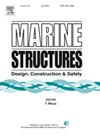Fatigue damage prediction model for broadband non-Gaussian random processes based on Bayesian optimized random forest
IF 5.1
2区 工程技术
Q1 ENGINEERING, CIVIL
引用次数: 0
Abstract
Marine structures operating in harsh ocean environments are continuously exposed to cyclic loads that may induce fatigue damage. Accurate fatigue damage prediction is therefore essential for ensuring the structural integrity of marine structures. When the structural responses exhibit broadband non-Gaussian characteristics, the existing frequency-domain methods appears to have insufficient accuracy. Although the time-domain rainflow counting method can achieve higher accuracy, it incurs high computational costs. To address these challenges, this study develops a fatigue damage prediction model for broadband non-Gaussian random processes by combining the random forest (RF) algorithm with Bayesian optimization (BO) approach. The BO-RF model is trained by employing the database including the fatigue damage related to diverse power spectra with a broad range of bandwidth parameters and a variety of S-N curve slope, skewness and kurtosis. Extensive numerical simulations demonstrate that the developed BO-RF model is superior to the tradition frequency-domain methods in terms of accuracy and robustness. Furthermore, comparative analysis against an artificial neural network (ANN) model further reveals the advantages of BO-RF model in both training efficiency and generalization capability. This study demonstrates the proposed BO-RF model can provide a feasible solution for accurate and efficient fatigue damage prediction of marine structures under broadband non-Gaussian random loading.
基于贝叶斯优化随机森林的宽带非高斯随机过程疲劳损伤预测模型
在恶劣的海洋环境中工作的海洋结构物不断地暴露在可能引起疲劳损伤的循环荷载下。因此,准确的疲劳损伤预测对于保证海洋结构的完整性至关重要。当结构响应表现出宽带非高斯特性时,现有的频域方法精度不足。时域雨流计数方法虽然精度较高,但计算成本较高。为了解决这些挑战,本研究将随机森林(RF)算法与贝叶斯优化(BO)方法相结合,开发了宽带非高斯随机过程的疲劳损伤预测模型。BO-RF模型的训练采用了包含多种功率谱、宽带宽参数和多种S-N曲线斜率、偏度和峰度的疲劳损伤数据库。大量的数值模拟表明,所建立的BO-RF模型在精度和鲁棒性方面都优于传统的频域方法。通过与人工神经网络(ANN)模型的对比分析,进一步揭示了BO-RF模型在训练效率和泛化能力方面的优势。研究表明,所提出的BO-RF模型能够为船舶结构在宽带非高斯随机载荷作用下的准确、高效的疲劳损伤预测提供一种可行的解决方案。
本文章由计算机程序翻译,如有差异,请以英文原文为准。
求助全文
约1分钟内获得全文
求助全文
来源期刊

Marine Structures
工程技术-工程:海洋
CiteScore
8.70
自引率
7.70%
发文量
157
审稿时长
6.4 months
期刊介绍:
This journal aims to provide a medium for presentation and discussion of the latest developments in research, design, fabrication and in-service experience relating to marine structures, i.e., all structures of steel, concrete, light alloy or composite construction having an interface with the sea, including ships, fixed and mobile offshore platforms, submarine and submersibles, pipelines, subsea systems for shallow and deep ocean operations and coastal structures such as piers.
 求助内容:
求助内容: 应助结果提醒方式:
应助结果提醒方式:


